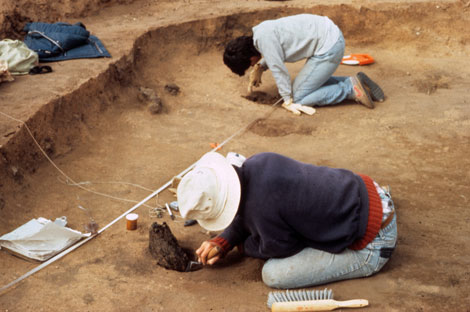

 Reclamation archaeologists identified and excavated all significant prehistoric and historic sites prior to construction of the Central Arizona Project. Reclamation photograph.
Reclamation archaeologists identified and excavated all significant prehistoric and historic sites prior to construction of the Central Arizona Project. Reclamation photograph.The 1968 congressional authorization of the Central Arizona Project initiated construction of a massive water delivery and storage project for central Arizona. It also led to one of the largest federal archaeology programs ever undertaken and provided a unique opportunity to look into Arizona's past.
 The CAP Collection. Reclamation is responsible for ensuring all federally owned cultural properties are protected and preserved. Reclamation Photograph.
The CAP Collection. Reclamation is responsible for ensuring all federally owned cultural properties are protected and preserved. Reclamation Photograph.One of the most important laws affecting archaeology in the United States was passed in 1966: The National Historic Preservation Act. This act declared that the historical and cultural foundations of the United States should be preserved. It acknowledged that historic sites important to the Nation's heritage were being lost at an accelerating rate, and that preserving this irreplaceable heritage was in the public interest. Urban sprawl, new freeways, public works projects, and other new developments were taking over formerly open spaces. Current governmental and non-governmental historic preservation programs were inadequate to address historic preservation issues.
Section 106 of the Act mandates that any Federal agency "having direct or indirect jurisdiction over a proposed Federal or federally-assisted undertaking in any State and the head of any Federal department or independent agency having authority to license any undertaking" shall, prior to spending any federal funds or issuing a federal license, take into account the effect of the undertaking on any area, building, or object that might be potentially eligible for listing in the National Register of Historic Places.
 Once significant data was recovered, Reclamation archaeologists ensured that it was collected, categorized, and published. Reclamation Photograph.
Once significant data was recovered, Reclamation archaeologists ensured that it was collected, categorized, and published. Reclamation Photograph.Before any excavations for the Central Arizona Project began, Reclamation archaeologists ensured that all significant prehistoric and historic sites were identified. If necessary, Reclamation conducted excavations or other appropriate investigations to recover significant data. Once recovered, Reclamation ensured that the results were published.
Section 110(a) sets inventory, nomination, protection, and preservation responsibilities for Federally-owned cultural properties. Section 110(c) requires each Federal agency to designate a Preservation Officer to coordinate activities under the act.
To read the entire law: http://www.achp.gov/docs/nhpa%202008.pdf
Laws guiding Reclamation: http://www.usbr.gov/cultural/legismandates.html
